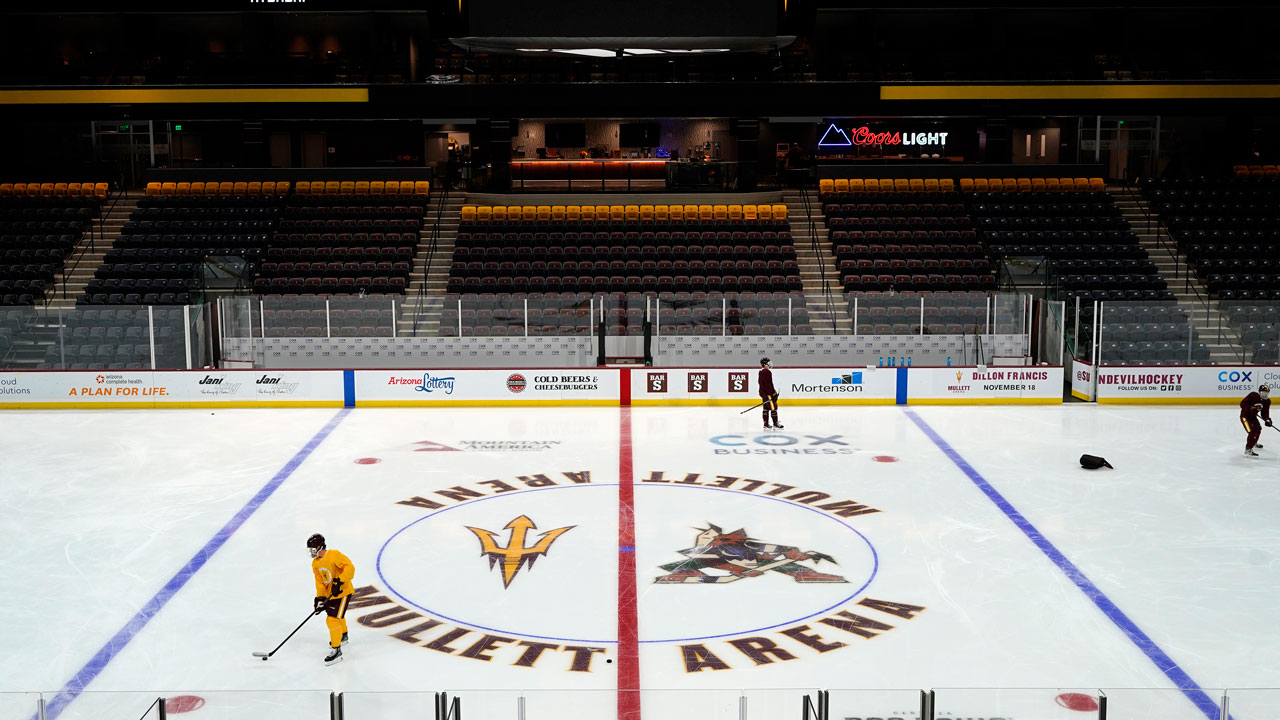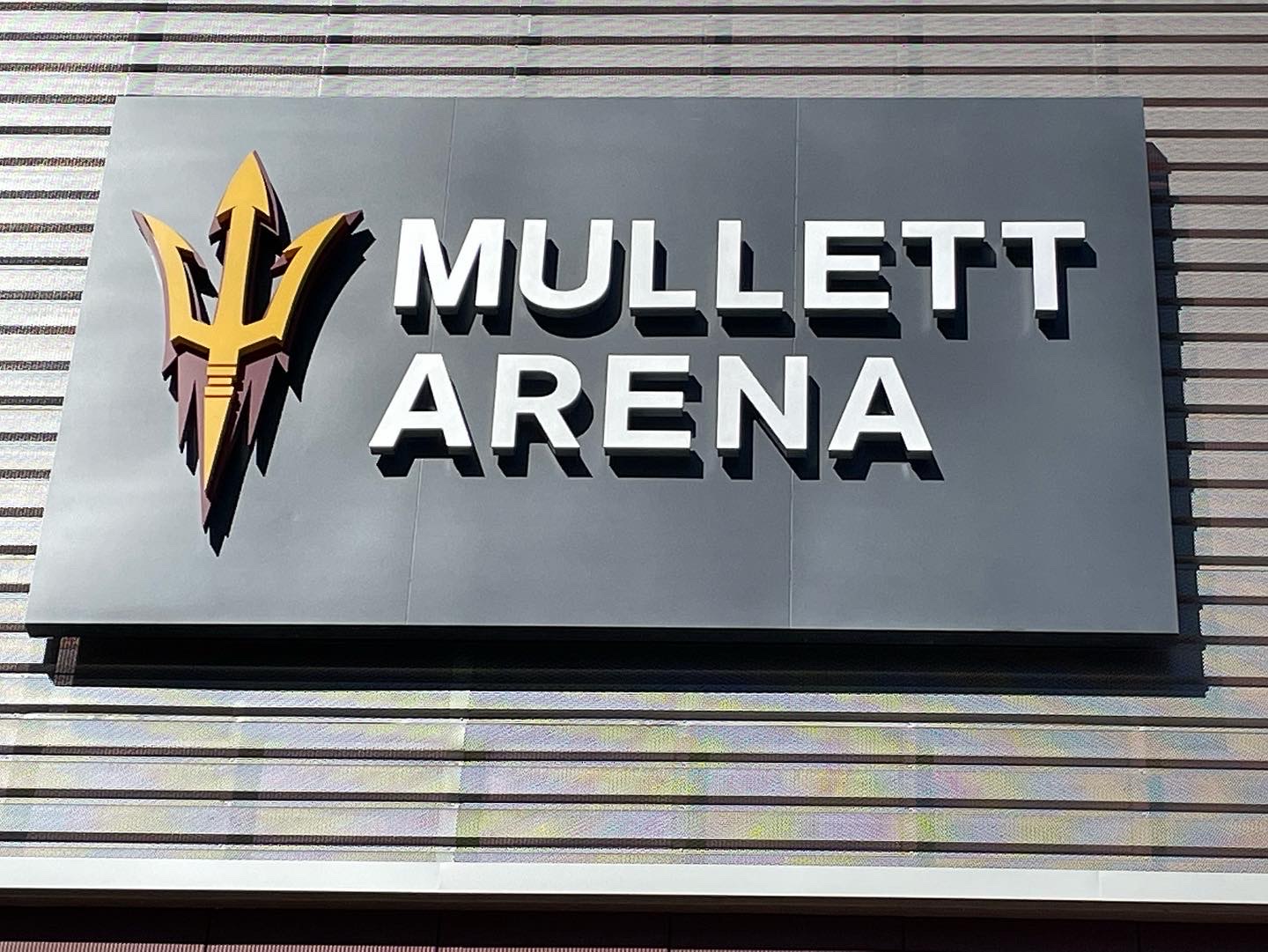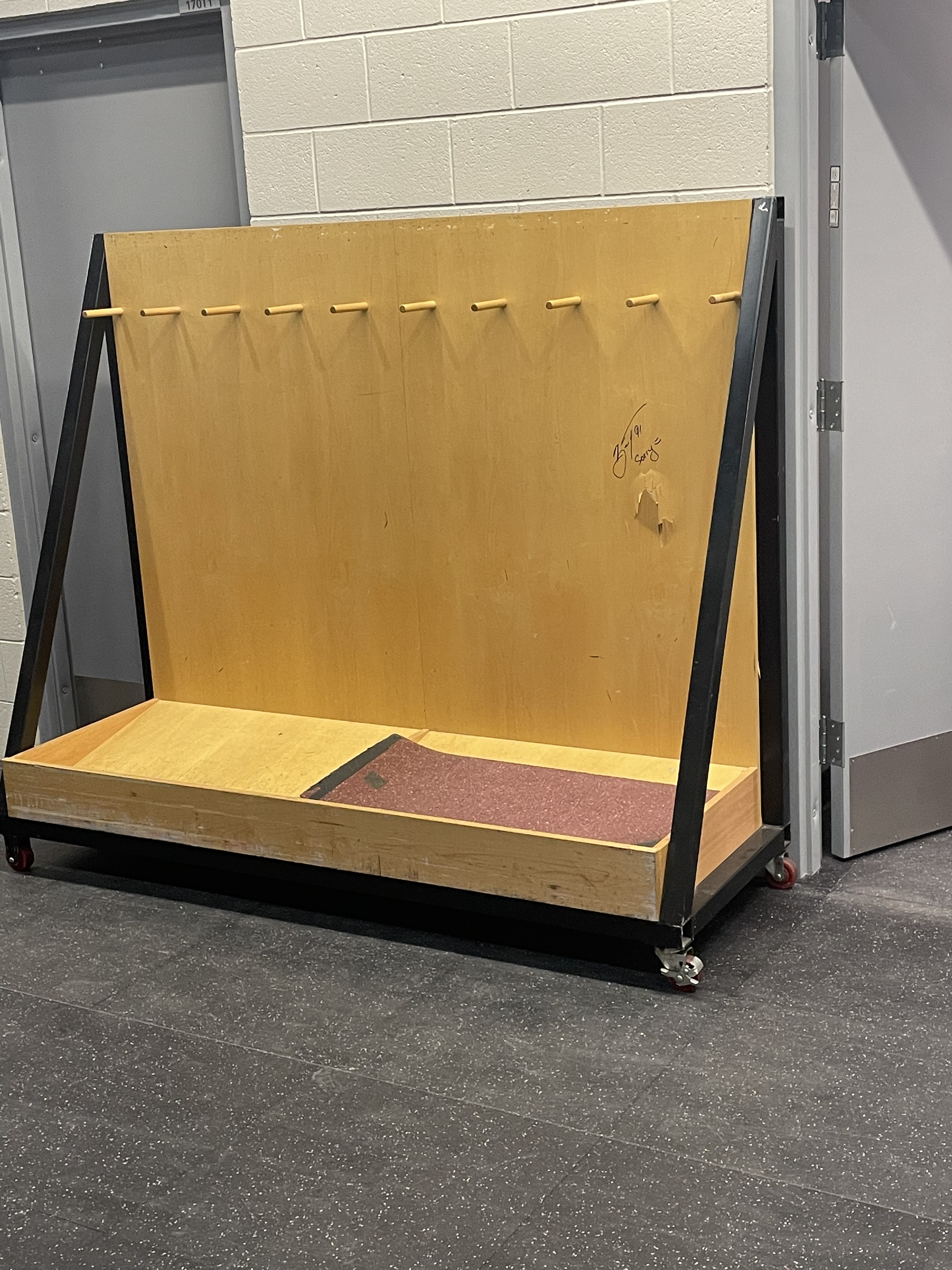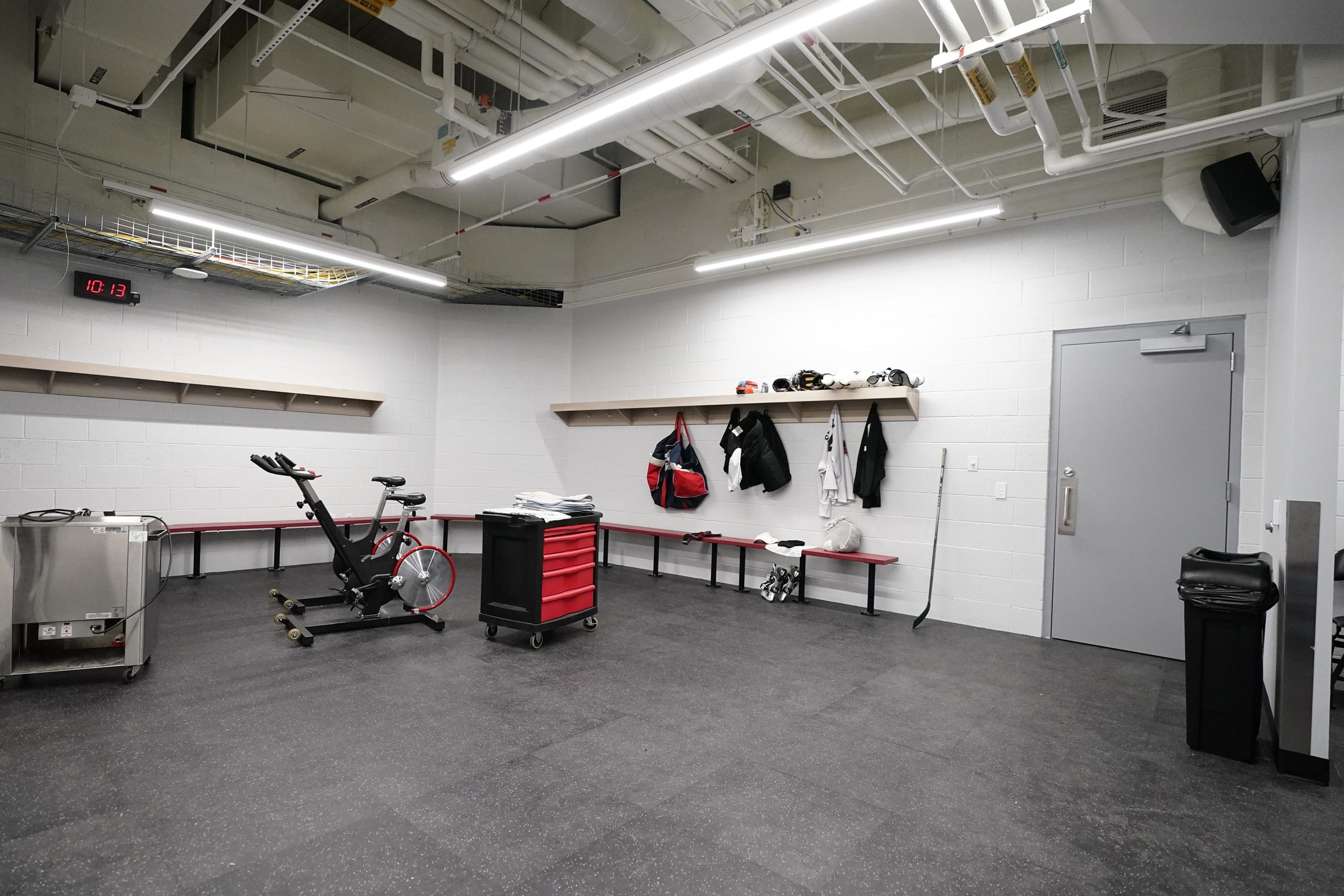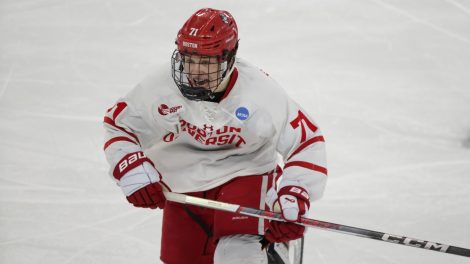TEMPE, Arizona – Nick Bjugstad provided as honest an answer as one could have asked for, given the circumstances.
On a day when the Arizona Coyotes were ushering in a new – if only temporary – era, the veteran forward was clearly leaning into the positive vibes while also making a concession about what this paradoxical situation is actually going to look like.
Depending on your point of view, having an NHL team playing in a state-of-the-art college arena could be the best of times, the worst of times – or somewhere in between.
“We still don’t know what to expect,” Bjugstad said after the Coyotes held their first practice at Mullett Arena, the full-time home of the Arizona State University Sun Devils, on Thursday. “Just kind of excitement. We’ll see how it goes.”
Upon first glance, it’s impossible not to be struck by the facility, which can hold just over 5,000 fans – which means there is no nosebleed section.
Those in attendance will be privy to one of the most intense fan experiences available at the professional level.
No, Mullett Arena won’t feature nearly all the bells and whistles of your standard NHL barn, but the sightlines are exceptional and the atmosphere should be fantastic in its own way.
“It’s different. I’m not going to sugarcoat it, but it’s a unique experience for everybody,” said Coyotes forward Zack Kassian. “Obviously, it’s not a 20,000- or 18,000-seat arena, so it gives it a different dynamic. So, it’s definitely cool and it’s our home, so we’ve got to get used to it and we’ve got to make it a tough place to play.
“There’s a lot more pros than cons.”
Coyotes head coach Andre Tourigny was happy to have his team home after a two-week road trip to start the season and was reminded of his days in the QMJHL when asked about what he expected the atmosphere to be like for the opener.
“If the fans are into it, it will be a unique experience and there will be a lot of emotion in there,” said Tourigny. “If the team on the ice is playing well and playing hard, for the fans that creates a bond between the fans and the team that is pretty strong.
“I’ve coached a long time and if you ask me about the crowd, the most intimidating place I’ve coached, people will be shocked. They would think Madison Square Garden or something like that, but it’s not. I could talk to you about the arena in Shawinigan. It’s crazy. Small barn, but when the people are on top of you and they are into it and there’s a lot of emotion, that’s intimidating.”
Interestingly enough, Coyotes rookie forward Dylan Guenther previously found himself in the opposite situation as a member of the Edmonton Oil Kings of the Western Hockey League.
The Oil Kings played at Rogers Place, also home of the Edmonton Oilers, so he’s well versed in playing in an NHL facility that often was nowhere near full capacity – something the Coyotes dealt with regularly at Gila River Arena in Glendale.
“I’m pumped,” said Guenther. “Rogers was a really nice facility, but some days it was quieter because they have the Oilers and whatnot. Playing in front of a sold out crowd is cool and with it being a smaller atmosphere, It’s going to be loud in there. I can’t wait to get out there for Game 1. That energy that you get from maybe a bit of a younger crowd too, we can kind of feed off that.”
Coyotes CEO Xavier Gutierrez went out of his way on numerous occasions to point out this solution was temporary, embracing the college campus atmosphere while stressing the next month could go a long way toward realizing the vision of majority owner Alex Meruelo, noting the three scheduled public hearings and expected vote on the proposed new arena in Tempe coming before the end of November.
“This is a brand new facility and we’ve made the investment to make it to NHL standards. It is intimate and you will have an unprecedented experience,” said Gutierrez. “It’s going to be loud and it’s going to be electric.”
Coyotes general manager Bill Armstrong was asked if playing on a college campus in a smaller building might have influenced his ability to compete for higher-end free agents in the recruiting department, but he dismissed that theory quickly.
“No, it’s easy because the wives make a huge impact and we’re the No. 1-rated city in the NHL to play in from the wives, so it’s a no-brainer,” said Armstrong. “We got a flat tax, so they’re not going to worry about that. We’ve got a good opportunity to build a new building here. We’re trying to become the new Tampa in the league. They were at this state where they played out of an airport hanger at one point In time and (now) they’re a premier franchise in the NHL. We’re trying to make that next step.
“We’ve got more cap room than anybody, so that’s not an issue in signing free agents. We can do that, but that’s not part of our plan. There’s a patience level to us moving through where we’re going right now of taking on bad contracts. We’re still in that mode. We haven’t flipped it to ‘Hey listen, let’s press go’ and take that next step. During the process, it also gives us an opportunity to play some of the younger players. They’ve earned it.”
Armstrong is hoping that over time, the Coyotes might be able to create a home-ice advantage at Mullett Arena.
“Let’s be honest, we’re all here because we wanted to see what it looks like,” said Armstrong. “It’s intriguing. I think we can have a special flavour here. We’re a physical team, we’re a grinding team. I would like to think we’re one of the hardest-working teams in the NHL. If you come to see us play, you’re going to get your money’s worth and when you come to see a game in this building, you’re going to have one of the best seats in the NHL.”
It goes without saying that this isn’t an optimal situation for the Coyotes or the teams visiting, especially for the first four home games, since the annex that is being constructed (by the Coyotes) and will include full locker rooms, won’t be completed.
That means the home team is using dressing rooms that are a bit more spread out than usual and the visitors’ complex has been constructed in what is normally the community rink.
Temporary stalls for the visiting team have been erected as part of the makeshift setup, but there are still a number of improvements to come.
Gutierrez said the Coyotes are in the neighbourhood of having 2,500 season-ticket holders but that he expects the building to be sold out each and every night.
He’s not concerned about the novelty wearing off during the next three seasons (plus the ability to add an option year), which is how long the current deal between the Coyotes and ASU is.
The early reviews are that the ice itself at Mullett Arena is excellent and the atmosphere should be festive, especially with between 200 and 400 student section tickets available in the end zone for $25.
Gutierrez said he wasn’t at liberty to reveal all of the surprises in store for Friday’s opener, but that a drumline will be included.
“Maybe it will be like the old days back at the University of Minnesota,” said Bjugstad, who was teammates with Winnipeg Jets blue-liner Nate Schmidt with the Golden Gophers. “If we could get the band from ASU here, that would be nice. It’s always fun and that changes the noise level. This is my 10th year in the league and you forget how loud those small arenas can get. I’m looking forward to that and I think guys coming into play are looking forward to it too.
“We’re still showing up and playing the same game and we’re playing in the NHL. There’s no complaints.”
It’s easy to applaud Bjugstad and company for taking that approach.
Making the best of the situation is the best route for the Coyotes – and their opponents – to take, but the truth of the matter is that there is still a lot of uncertainty over how this whole situation will play out in both the short and long term.
A commitment has been made by all parties to make it work and things are certainly going to improve considerably once the annex is complete and the Coyotes return home for their next homestand in December.
That will mean a better dressing room situation and eliminate one of the logistical challenges for both the home and road teams.
Jets associate coach Scott Arniel was asked by reporters in Los Angeles on Thursday about being the Coyotes first opponent at Mullett Arena, and he was taking a wait-and-see approach before making any snap judgements.
“Yeah, it’ll be interesting to see how the coaching situation is and the dressing room. We hear it’s going to be a little bit different,” said Arniel. “Not much you can do about it. I don’t think it’s any better for Arizona either. I think both teams will be coming into something new.”
There is certainly some irony involved with the Coyotes playing the Jets in the first NHL game at Mullett Arena, since the two franchises will forever be linked.
Perhaps it’s more than just a coincidence the team the Jets became is serving as the opponent.
Since the 2.0 version returned to Winnipeg in 2011, the Jets have much more control of their situation than they did before they departed to the desert in 1996.
Given all of the efforts the NHL has taken to ensure the NHL remains in Arizona, the Jets represent what the Coyotes nearly became before relocation efforts shifted to the Atlanta Thrashers.
They also represent the possibilities for the future, should a new arena and sports facility get built in Tempe.

